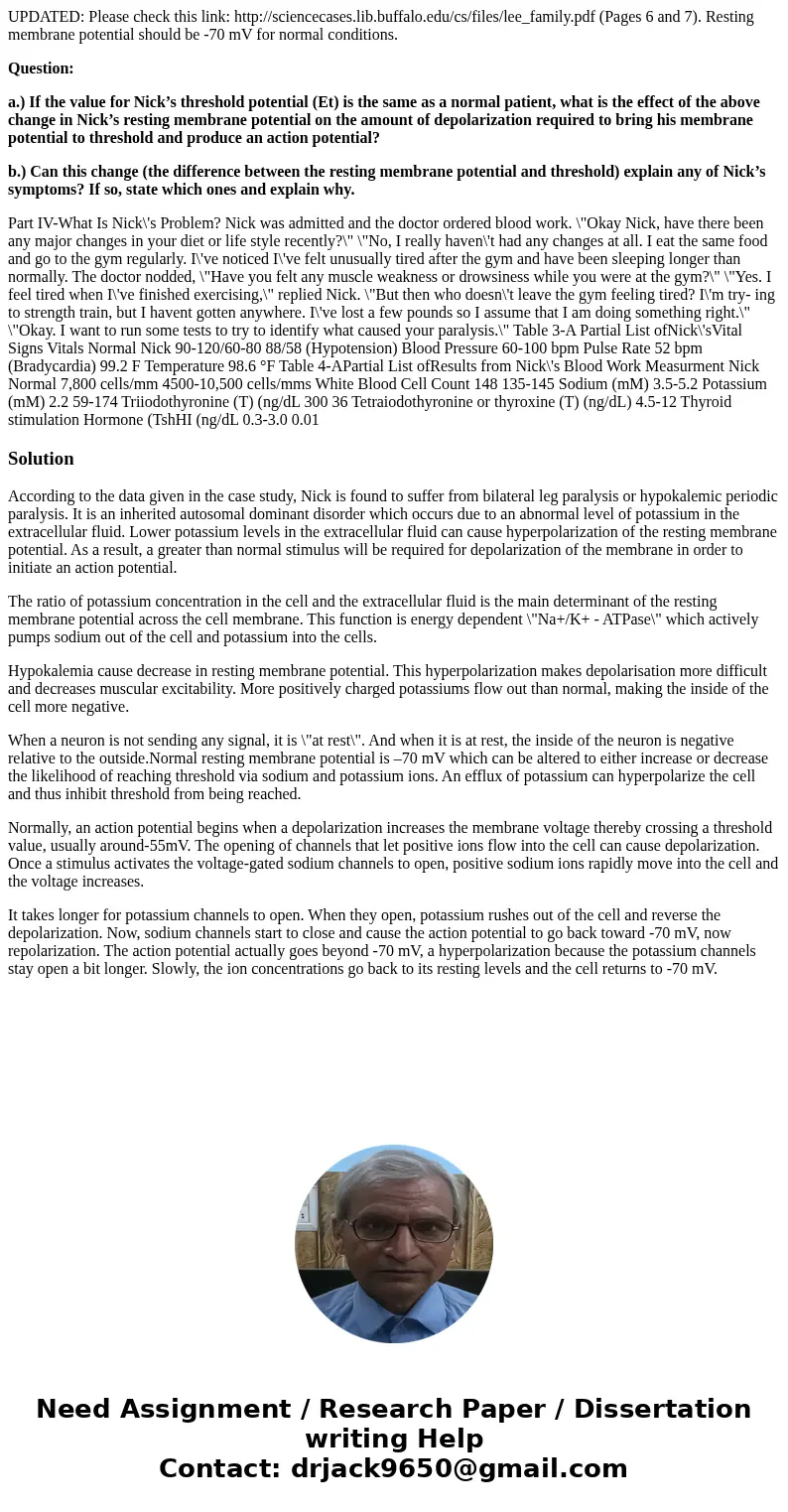UPDATED Please check this link httpsciencecaseslibbuffaloedu
UPDATED: Please check this link: http://sciencecases.lib.buffalo.edu/cs/files/lee_family.pdf (Pages 6 and 7). Resting membrane potential should be -70 mV for normal conditions.
Question:
a.) If the value for Nick’s threshold potential (Et) is the same as a normal patient, what is the effect of the above change in Nick’s resting membrane potential on the amount of depolarization required to bring his membrane potential to threshold and produce an action potential?
b.) Can this change (the difference between the resting membrane potential and threshold) explain any of Nick’s symptoms? If so, state which ones and explain why.
Part IV-What Is Nick\'s Problem? Nick was admitted and the doctor ordered blood work. \"Okay Nick, have there been any major changes in your diet or life style recently?\" \"No, I really haven\'t had any changes at all. I eat the same food and go to the gym regularly. I\'ve noticed I\'ve felt unusually tired after the gym and have been sleeping longer than normally. The doctor nodded, \"Have you felt any muscle weakness or drowsiness while you were at the gym?\" \"Yes. I feel tired when I\'ve finished exercising,\" replied Nick. \"But then who doesn\'t leave the gym feeling tired? I\'m try- ing to strength train, but I havent gotten anywhere. I\'ve lost a few pounds so I assume that I am doing something right.\" \"Okay. I want to run some tests to try to identify what caused your paralysis.\" Table 3-A Partial List ofNick\'sVital Signs Vitals Normal Nick 90-120/60-80 88/58 (Hypotension) Blood Pressure 60-100 bpm Pulse Rate 52 bpm (Bradycardia) 99.2 F Temperature 98.6 °F Table 4-APartial List ofResults from Nick\'s Blood Work Measurment Nick Normal 7,800 cells/mm 4500-10,500 cells/mms White Blood Cell Count 148 135-145 Sodium (mM) 3.5-5.2 Potassium (mM) 2.2 59-174 Triiodothyronine (T) (ng/dL 300 36 Tetraiodothyronine or thyroxine (T) (ng/dL) 4.5-12 Thyroid stimulation Hormone (TshHI (ng/dL 0.3-3.0 0.01Solution
According to the data given in the case study, Nick is found to suffer from bilateral leg paralysis or hypokalemic periodic paralysis. It is an inherited autosomal dominant disorder which occurs due to an abnormal level of potassium in the extracellular fluid. Lower potassium levels in the extracellular fluid can cause hyperpolarization of the resting membrane potential. As a result, a greater than normal stimulus will be required for depolarization of the membrane in order to initiate an action potential.
The ratio of potassium concentration in the cell and the extracellular fluid is the main determinant of the resting membrane potential across the cell membrane. This function is energy dependent \"Na+/K+ - ATPase\" which actively pumps sodium out of the cell and potassium into the cells.
Hypokalemia cause decrease in resting membrane potential. This hyperpolarization makes depolarisation more difficult and decreases muscular excitability. More positively charged potassiums flow out than normal, making the inside of the cell more negative.
When a neuron is not sending any signal, it is \"at rest\". And when it is at rest, the inside of the neuron is negative relative to the outside.Normal resting membrane potential is –70 mV which can be altered to either increase or decrease the likelihood of reaching threshold via sodium and potassium ions. An efflux of potassium can hyperpolarize the cell and thus inhibit threshold from being reached.
Normally, an action potential begins when a depolarization increases the membrane voltage thereby crossing a threshold value, usually around-55mV. The opening of channels that let positive ions flow into the cell can cause depolarization. Once a stimulus activates the voltage-gated sodium channels to open, positive sodium ions rapidly move into the cell and the voltage increases.
It takes longer for potassium channels to open. When they open, potassium rushes out of the cell and reverse the depolarization. Now, sodium channels start to close and cause the action potential to go back toward -70 mV, now repolarization. The action potential actually goes beyond -70 mV, a hyperpolarization because the potassium channels stay open a bit longer. Slowly, the ion concentrations go back to its resting levels and the cell returns to -70 mV.

 Homework Sourse
Homework Sourse